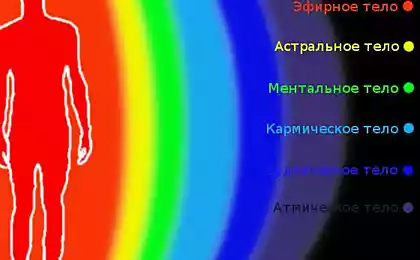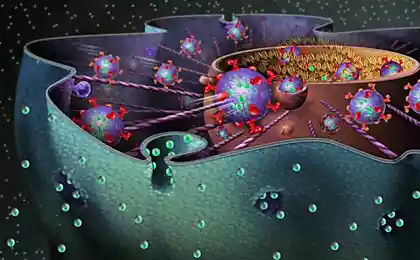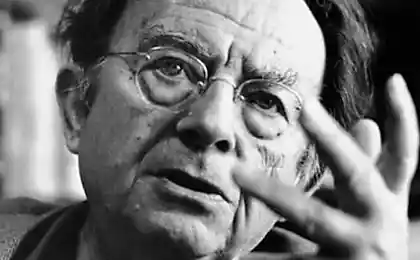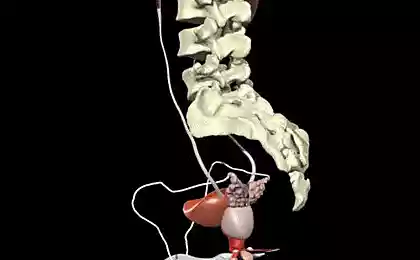835
The difference from the usual creative person
What distinguishes the creative person of the uncreative
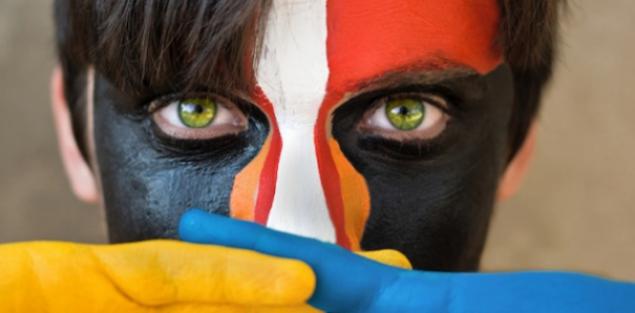
Creativity is inscrutable and often paradoxical. Stable creative thinking is a defining characteristic of some individuals, but it can vary depending on the situation and the environment. Often, inspiration and new ideas appear, seemingly out of nowhere, and then when we most need them, they disappear. Creative thinking requires an integrated perception, it is completely different from the thought process.
Neurobiology paints a complex picture of creativity. Scientists now understand that the nature of creativity is much more complicated than the differences in the right- or left-handed orientation of the brain (left hemisphere = rational and analytical, right = creative and emotional). In fact, creativity is believed to be due to a number of cognitive processes, nerve impulses and emotions, and we still do not have a complete picture of how the creative mind works.
From a psychological point of view of the creative personality types are difficult to define. They are complex, paradoxical, and tend to avoid routine. And it's not just a stereotype of the "tortured artist". Studies have shown that creativity involves the interaction of many traits of behavior and social influences all rolled into one.
"In fact, creative people find themselves harder because they are more difficult than non-creative" - said the Huffington Post Scott Barry Kaufman, a psychologist at New York University, who has spent years of research creativity. "What is most paradoxical in a creative personality ... these people have a chaotic mind».
There is no "typical" portrait of a creative personality, but there are special features in the behavior of creative people. Here are 18 items that are peculiar to them.
They dream
Creative individuals dreamers, despite the fact that their school teachers may say that dreaming is a waste of time.
Kaufman and psychologist Rebecca L. McMillan, she is co-author of the document entitled "Ode to the positive creative reverie", believe that the wandering mind can help in the process of "creative incubation." And, of course, many know from experience that the best ideas visit us when we are mentally somewhere else.
Neuroscientists have found that imagination involves the same brain processes that are associated with imagination and creativity.
They all notice
Creative people see opportunities everywhere and constantly absorbs information that becomes food for creative expression. How often cited Henry James, the writer is the one from whom "nothing escapes».
Joan Didion has always carried a notebook and said that it records observations about people and events, which ultimately helped her to better understand the complexities and contradictions of his own mind.
They have their work hours
Many great masters recognized that their best work they create or very early in the morning or late in the evening. Vladimir Nabokov began writing immediately after waking up at 6 or 7 am, and Frank Lloyd Wright made it a habit of waking up at 3 or 4 o'clock in the morning and worked for a few hours before heading back to bed. People with high creative potential do not adhere to the standard of the daily routine.
They find time for solitude
"In order to be open to creativity, you need to have the ability to constructive use of solitude. It is necessary to overcome the fear of loneliness, "- wrote the American existential psychologist Rollo May.
Artists and creators often stereotyped as a single, but in fact they they may not be. Solitude can be the key to creating the best works. Kaufman attributes this to the imagination - we need to give yourself time to just dream.
"You need to get in touch with the inner voice, to be able to express themselves. It is difficult to hear their inner creative voice, if you ... are not in contact with yourself and do not reflect on themselves ", - he said.
They "digest" the vital barriers
Many of the most iconic stories and songs of all time worked under the influence of heartbreaking pain. Often the problem becomes the catalyst for the creation of outstanding works. In psychology this is called post-traumatic growth, which suggests that people are able to use their hardships and trauma early in life for a substantial creative growth. The researchers found that the injury can help a person succeed in interpersonal relationships, satisfaction with life, spiritual growth, personal power and the opening of new possibilities.
They are in search of new experiences
Creative people like to experience new impressions, feelings and state of mind, and this is an important predictor for creative results.
"Openness to new experiences is the strongest predictor of creative achievements," - says Kaufman. "There are many different interrelated aspects: intellectual curiosity, the search for thrills, openness to emotions and imagination. And all together - is the engine for the knowledge and research of the world, both internal and external ».
They fail
Resistance - practically necessary quality for creative success, says Kaufman. Failure often lurks a creative person, at least a few times, but creative people - at least, successful - learn not grieve about this.
"Creative people fail, but really good, it is often tolerated," - wrote at Forbes Steven Kotler in the passage of the creative genius of Einstein.
They ask important questions
Creative people are insatiably curious. They usually prefer to explore the life and even when mature, remain interested discoverer. Through active conversation or individual mental thinking creatives looking at the world, constantly asking themselves a lot of questions.
They watch people
Nature observation and interest in the lives of others sometimes helps to generate the best ideas.
"Marcel Proust almost his entire life spent watching people, he wrote down his comments, and it found an outlet in his books," - says Kaufman. "For many writers it is important to monitor the people ...».
They risk
Part of the creative activity requires risky and many successful creative individuals have to take risks in different aspects of life.
"There is a profound and significant association between risk-taking and creativity, and this is often overlooked," - writes Steven Kotler in Forbes. "Creativity is the act of creating something out of nothing. It requires the disclosure of the fact that first existed only in the imagination. This is not for the timid. Wasted time, tarnished reputation, wasted money - ... It's all the side effects that creativity goes awry ».
They are all in my life seen as an opportunity for self-expression
Nietzsche believed that life and the world should be seen as a work of art. Creative individuals are constantly looking for opportunities to express themselves in everyday life.
"Creative expression - is self-expression. Creativity is not that other, as a private expression of your needs, desires and uniqueness, "- says Kaufman.
They follow their true passion
Creative people tend to have the intrinsic motivation. This means that they are guided by some inner desire, rather than the desire for external rewards or recognition.
Psychologists say that creative people are excited exciting activities, and a sign of internal motivation. Studies show that a simple reflection on the reasons for the activities of their own can be quite challenging to enhance the creative potential.
They go beyond the boundaries of his own mind
Kaufman argues that the ability to dream is still needed in order to help us to go beyond the usual vision and to explore other ways of thinking, which can be an important asset for creativity.
"Reverie developed to allow us to let go now," - says Kaufman. "The network of the brain linked to daydreaming, is a network of the brain associated with theory of mind. I like to call it "network of the imagination" - it allows you to imagine yourself in the future as well as present the thoughts of others ».
They lose all sense of time
Creative individuals may find that when they write, dance, draw, or even somehow express themselves, they are "in a state of flux", which helps them to do at the highest level. It is a mental condition where a person goes beyond the conscious mind to achieve a state of heightened concentration and tranquility. Then he practically is not subject of any internal or external stimuli that could interfere with its work.
You are "in a state of flux" when doing what you really like, from what feels good.
They surround themselves with beauty
Creators tend to have excellent taste and like to be in a beautiful environment.
A study recently published in the journal «Psychology of Aesthetics, Creativity, and the Arts», showed that musicians, including music teachers and soloists, show a high sensitivity and sensitivity to artistic beauty.
They connect the dots
If there is a difference between highly creative people and all the others, is the ability to see opportunities where others do not notice. Many great artists and writers say that creativity is simply the ability to connect the dots that others would never have guessed connect.
Steve Jobs said that the work of an association of things. When you ask creative people how they did it, they feel a little uncomfortable, because in reality they did not do, but just something to make out, combined with their experience and synthesize new things.
They are constantly shaken
The variety of experience, more than anything else is crucial to creativity, says Kaufman. Creatives shaken, experiencing new things and avoid everything that makes life monotonous and routine.
"The creative people a greater variety of experiences," - says Kaufman.
They find time for meditation and mindfulness
Creative individuals understand the value of a clear and focused mind, because it affects their work. Many artists, entrepreneurs, writers and other creative figures used meditation as a tool to adjust the most creative state of mind.
Dutch study in 2012 showed that some meditation techniques really contribute to creative thinking. Awareness is associated with improvements in memory and attention, emotional state optimization, reducing stress and anxiety, as well as improved mental clarity - all of which can lead to more creative thinking.
©

Creativity is inscrutable and often paradoxical. Stable creative thinking is a defining characteristic of some individuals, but it can vary depending on the situation and the environment. Often, inspiration and new ideas appear, seemingly out of nowhere, and then when we most need them, they disappear. Creative thinking requires an integrated perception, it is completely different from the thought process.
Neurobiology paints a complex picture of creativity. Scientists now understand that the nature of creativity is much more complicated than the differences in the right- or left-handed orientation of the brain (left hemisphere = rational and analytical, right = creative and emotional). In fact, creativity is believed to be due to a number of cognitive processes, nerve impulses and emotions, and we still do not have a complete picture of how the creative mind works.
From a psychological point of view of the creative personality types are difficult to define. They are complex, paradoxical, and tend to avoid routine. And it's not just a stereotype of the "tortured artist". Studies have shown that creativity involves the interaction of many traits of behavior and social influences all rolled into one.
"In fact, creative people find themselves harder because they are more difficult than non-creative" - said the Huffington Post Scott Barry Kaufman, a psychologist at New York University, who has spent years of research creativity. "What is most paradoxical in a creative personality ... these people have a chaotic mind».
There is no "typical" portrait of a creative personality, but there are special features in the behavior of creative people. Here are 18 items that are peculiar to them.
They dream
Creative individuals dreamers, despite the fact that their school teachers may say that dreaming is a waste of time.
Kaufman and psychologist Rebecca L. McMillan, she is co-author of the document entitled "Ode to the positive creative reverie", believe that the wandering mind can help in the process of "creative incubation." And, of course, many know from experience that the best ideas visit us when we are mentally somewhere else.
Neuroscientists have found that imagination involves the same brain processes that are associated with imagination and creativity.
They all notice
Creative people see opportunities everywhere and constantly absorbs information that becomes food for creative expression. How often cited Henry James, the writer is the one from whom "nothing escapes».
Joan Didion has always carried a notebook and said that it records observations about people and events, which ultimately helped her to better understand the complexities and contradictions of his own mind.
They have their work hours
Many great masters recognized that their best work they create or very early in the morning or late in the evening. Vladimir Nabokov began writing immediately after waking up at 6 or 7 am, and Frank Lloyd Wright made it a habit of waking up at 3 or 4 o'clock in the morning and worked for a few hours before heading back to bed. People with high creative potential do not adhere to the standard of the daily routine.
They find time for solitude
"In order to be open to creativity, you need to have the ability to constructive use of solitude. It is necessary to overcome the fear of loneliness, "- wrote the American existential psychologist Rollo May.
Artists and creators often stereotyped as a single, but in fact they they may not be. Solitude can be the key to creating the best works. Kaufman attributes this to the imagination - we need to give yourself time to just dream.
"You need to get in touch with the inner voice, to be able to express themselves. It is difficult to hear their inner creative voice, if you ... are not in contact with yourself and do not reflect on themselves ", - he said.
They "digest" the vital barriers
Many of the most iconic stories and songs of all time worked under the influence of heartbreaking pain. Often the problem becomes the catalyst for the creation of outstanding works. In psychology this is called post-traumatic growth, which suggests that people are able to use their hardships and trauma early in life for a substantial creative growth. The researchers found that the injury can help a person succeed in interpersonal relationships, satisfaction with life, spiritual growth, personal power and the opening of new possibilities.
They are in search of new experiences
Creative people like to experience new impressions, feelings and state of mind, and this is an important predictor for creative results.
"Openness to new experiences is the strongest predictor of creative achievements," - says Kaufman. "There are many different interrelated aspects: intellectual curiosity, the search for thrills, openness to emotions and imagination. And all together - is the engine for the knowledge and research of the world, both internal and external ».
They fail
Resistance - practically necessary quality for creative success, says Kaufman. Failure often lurks a creative person, at least a few times, but creative people - at least, successful - learn not grieve about this.
"Creative people fail, but really good, it is often tolerated," - wrote at Forbes Steven Kotler in the passage of the creative genius of Einstein.
They ask important questions
Creative people are insatiably curious. They usually prefer to explore the life and even when mature, remain interested discoverer. Through active conversation or individual mental thinking creatives looking at the world, constantly asking themselves a lot of questions.
They watch people
Nature observation and interest in the lives of others sometimes helps to generate the best ideas.
"Marcel Proust almost his entire life spent watching people, he wrote down his comments, and it found an outlet in his books," - says Kaufman. "For many writers it is important to monitor the people ...».
They risk
Part of the creative activity requires risky and many successful creative individuals have to take risks in different aspects of life.
"There is a profound and significant association between risk-taking and creativity, and this is often overlooked," - writes Steven Kotler in Forbes. "Creativity is the act of creating something out of nothing. It requires the disclosure of the fact that first existed only in the imagination. This is not for the timid. Wasted time, tarnished reputation, wasted money - ... It's all the side effects that creativity goes awry ».
They are all in my life seen as an opportunity for self-expression
Nietzsche believed that life and the world should be seen as a work of art. Creative individuals are constantly looking for opportunities to express themselves in everyday life.
"Creative expression - is self-expression. Creativity is not that other, as a private expression of your needs, desires and uniqueness, "- says Kaufman.
They follow their true passion
Creative people tend to have the intrinsic motivation. This means that they are guided by some inner desire, rather than the desire for external rewards or recognition.
Psychologists say that creative people are excited exciting activities, and a sign of internal motivation. Studies show that a simple reflection on the reasons for the activities of their own can be quite challenging to enhance the creative potential.
They go beyond the boundaries of his own mind
Kaufman argues that the ability to dream is still needed in order to help us to go beyond the usual vision and to explore other ways of thinking, which can be an important asset for creativity.
"Reverie developed to allow us to let go now," - says Kaufman. "The network of the brain linked to daydreaming, is a network of the brain associated with theory of mind. I like to call it "network of the imagination" - it allows you to imagine yourself in the future as well as present the thoughts of others ».
They lose all sense of time
Creative individuals may find that when they write, dance, draw, or even somehow express themselves, they are "in a state of flux", which helps them to do at the highest level. It is a mental condition where a person goes beyond the conscious mind to achieve a state of heightened concentration and tranquility. Then he practically is not subject of any internal or external stimuli that could interfere with its work.
You are "in a state of flux" when doing what you really like, from what feels good.
They surround themselves with beauty
Creators tend to have excellent taste and like to be in a beautiful environment.
A study recently published in the journal «Psychology of Aesthetics, Creativity, and the Arts», showed that musicians, including music teachers and soloists, show a high sensitivity and sensitivity to artistic beauty.
They connect the dots
If there is a difference between highly creative people and all the others, is the ability to see opportunities where others do not notice. Many great artists and writers say that creativity is simply the ability to connect the dots that others would never have guessed connect.
Steve Jobs said that the work of an association of things. When you ask creative people how they did it, they feel a little uncomfortable, because in reality they did not do, but just something to make out, combined with their experience and synthesize new things.
They are constantly shaken
The variety of experience, more than anything else is crucial to creativity, says Kaufman. Creatives shaken, experiencing new things and avoid everything that makes life monotonous and routine.
"The creative people a greater variety of experiences," - says Kaufman.
They find time for meditation and mindfulness
Creative individuals understand the value of a clear and focused mind, because it affects their work. Many artists, entrepreneurs, writers and other creative figures used meditation as a tool to adjust the most creative state of mind.
Dutch study in 2012 showed that some meditation techniques really contribute to creative thinking. Awareness is associated with improvements in memory and attention, emotional state optimization, reducing stress and anxiety, as well as improved mental clarity - all of which can lead to more creative thinking.
©


